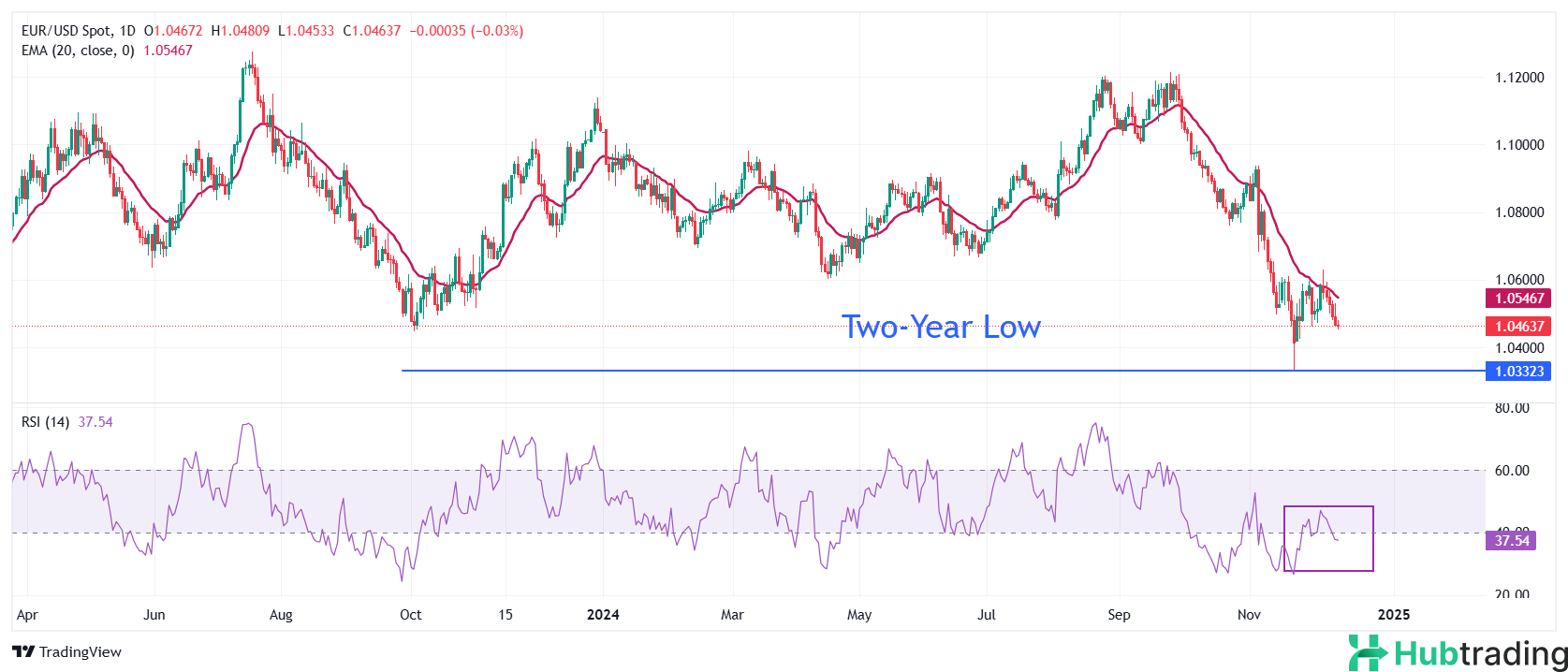- EUR/USD advances toward 1.0500 as the US Dollar relinquishes its intraday gains.
- The ECB cut its key borrowing rate by 25 basis points on Thursday, with some officials suggesting the potential for a 50-bps reduction.
- Fed officials are anticipated to provide mildly hawkish guidance on interest rates on Wednesday.
EUR/USD rises as the US Dollar (USD) pares intraday gains, climbing toward 1.0500 during Friday’s North American session. The US Dollar Index (DXY), which measures the Greenback against six major currencies, declines after encountering selling pressure above 107.00. This dip occurs despite solid expectations for the Federal Reserve (Fed) to adopt a slightly hawkish stance on interest rates following a 25-basis-point (bps) rate cut to 4.25%-4.50% during Wednesday’s policy meeting.
According to the CME FedWatch tool, traders have fully priced in a 25-bps rate reduction on Wednesday while anticipating rates to remain steady at 4.25%-4.50% in January’s meeting.
“The recent slowdown in US disinflation, a lower-than-expected Unemployment Rate compared to the Fed’s September projections, and buoyant US financial markets are driving this more hawkish stance,” analysts at Macquarie explained.
Adding to this outlook, November’s US Producer Price Index (PPI) data showed a faster-than-expected acceleration. The report revealed annual headline PPI rose by 3%, while core PPI—excluding food and energy—climbed by 3.4%, reinforcing the possibility of a firmer Fed stance on interest rates.
Daily Market Digest: EUR/USD Gains Despite Dovish ECB Signals
- EUR/USD Nears 1.0500 Amid Dovish ECB Tone: The pair edges higher as key European Central Bank (ECB) officials deliver dovish remarks on interest rate guidance following the end of the blackout period. Bank of France Governor François Villeroy de Galhau, Latvian central bank Governor Mārtiņš Kazāks, and Bank of Estonia Governor Madis Müller expressed support for further interest rate cuts, dampening the Euro’s broader outlook.
- ECB President Signals Further Rate Cuts: On Thursday, ECB President Christine Lagarde reinforced expectations for additional policy easing after the central bank cut the Deposit Facility rate by 25 basis points (bps) to 3%. Lagarde cited weakening Eurozone growth, driven by declining exports and subdued business investment. She noted, “Surveys indicate that manufacturing is still contracting and growth in services is slowing,” and added that firms are scaling back investments due to weak demand and economic uncertainty.
- Concerns Over Economic Growth: Lagarde revealed that some ECB officials favored a larger 50-bps rate cut, reflecting heightened concerns about faltering economic activity. The latest ECB projections indicate the Eurozone economy will grow by 0.7% in 2024 and 1.1% in 2025, down from earlier forecasts.
- Inflation Outlook: Lagarde expressed confidence in inflation returning to the ECB’s 2% target by 2025. On the potential inflationary effects of higher U.S. import tariffs, she stated these measures are “probably net inflationary” in the short term but emphasized the impact would depend on the scope, retaliation, and trade rerouting.
- Eurozone Industrial Production Data: October’s Eurozone Industrial Production remained flat, outperforming expectations of a 0.1% decline after September’s sharp contraction. Year-on-year, Industrial Production fell by 1.2%, better than forecasts of a 1.9% drop.
Technical Analysis: EUR/USD Holds Below 20-Day EMA

EUR/USD edges back toward the psychological level of 1.0500 but maintains a bearish outlook after retreating from its recent mean-reversion move near the 20-day Exponential Moving Average (EMA), currently around 1.0580 and nearing 1.0550 at press time.
The 14-day Relative Strength Index (RSI) has dropped below 40.00, signaling a resumption of bearish momentum.
The two-year low at 1.0330 remains a critical level to watch on the downside.
The 20-day EMA continues to act as a significant hurdle for Euro bulls.
A sustained move below the 1.0500 level could expose the pair to further losses, while a break above the 20-day EMA would signal potential recovery.





